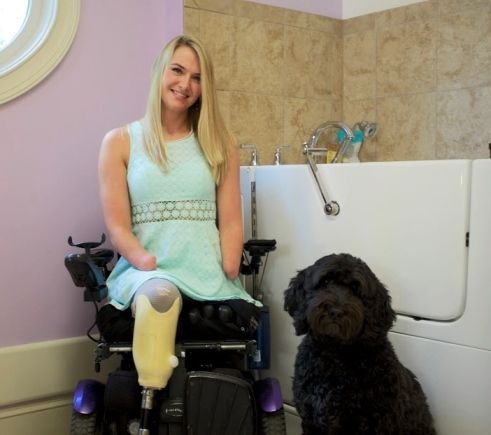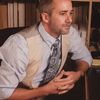This article, the fourth of a five-part series, originally appeared in the November/December 2016 issue of inMotion, the bi-monthly publication of the Amputee Coalition. Contact the Amputee Coalition to learn how you can get involved in lowering the bar for people living with limb loss and limb difference.]
SNELLVILLE, Georgia — Events divide lives into chapters.
The story of any individual life includes long interludes of normalcy, punctuated by occasions of significance. It’s not just living day after day that makes a life interesting or a life’s story worth telling — it’s the moments of demarcation that separate all that went before from all that is to come. We are defined by our changes. Some changes are a matter of our choosing, while others befall us without notice. The meaningful changes are those that we can’t undo — like marriage, parenthood, loss of a loved one, or of a limb.

Aimee Copeland at home
Like everyone living with limb loss, Aimee Copeland’s life includes a chapter before limb loss, 24 years as an able-bodied, inquisitive woman with a future as bright as her smile, and those chapters now lived and still to come as an amputee. In Copeland’s case, the amputee chapters of her story are as uplifting and emboldening as any chapter of any able-bodied life. Her life reads like the most uplifting of novels.
Snellville, Georgia, Copeland’s home town, is a town all of America still wants to be. Its population of 18,000 live up to their town motto: “Where everybody is proud to be somebody.” In 2012, Copeland, a proud Snellvillian and graduate student at the University of West Georgia in nearby Carrollton, ended her shift at local café and went off with friends to spend a perfect May afternoon at the river. Copeland and her friends took turns crossing the river on a homemade zip-line suspended six feet over the water. On Copeland’s second pass the line snapped, and she fell into sharp rocks below slicing open her left calf.
It took 22 staples at the local hospital to close the wound. Copeland was sent home where, over the next few days, “Something just didn’t feel right in my leg.”
What didn’t feel right was the Aeromonas hydrophila she contracted from the river water. A hydrophila is a flesh-eating bacteria every bit as nasty as it sounds. It can survive in aerobic or anaerobic environments. It thrives in fresh or brackish water. It is resistant to heat, cold and antibiotics and can digest organic matter, including the flesh exposed by an open wound. Once it enters the bloodstream it produces a toxin that spreads rapidly, destroying organs and tissues as it goes.
Three days after her fall Copeland woke unable to speak, her left leg rotted up to her thigh. Her boyfriend carried her to the car and sped to the hospital where she was diagnosed with necrotizing fasciitis. The medical staff responded with life-saving urgency and halted the bacteria’s spread before it could claim a young life. To save Copeland they were forced to amputate both arms below the elbow, her right leg below the knee, and her left leg at the hip.
A young woman full of life, a graduate student and part-time waitress in scenic small-town America was thus left a quadruple amputee – the end of one chapter in life; the beginning of another.
As Copeland tells it, “I lived the first 24 years of my life with no real knowledge or appreciation of the challenges faced by people with limitations or the adaptations that can help them live full and independent lives.”
Following a long hospitalization, she began the arduous process of recovery while living with her parents. “I think my entire life up until the accident was preparing me for life afterward,” says Copeland. “I knew that I had to create meaning for myself so I recognized and owned the choice to live as independently as possible and move forward with my goals in life.”
After two years at her parents’ home following her goals meant moving to a home of her own in Atlanta. With master’s degrees in psychology and social work, Copeland is currently studying for Board exams and working as a counselor to become a Licensed Clinical Social Worker. Copeland credits her background in psychology with insights into her own adjustment that helped her to overcome loss and find purpose in her new life.
“The process of limb loss is more like depression than grieving the loss of a loved one,” she explains. “With limb loss there’s the sense of personal inadequacy – I’m not good enough, no one will ever love me, that sort of thing.” Loving oneself in one’s new, altered body is a challenge every amputee faces, a challenge Copeland meets every day. She is active in the community and works with several local nonprofits.
She makes it seem easy, living with no complete limbs. But life in Copeland’s new body demanded accommodations. The lessons she has learned and implemented in her home are lessons she’s eager to share with others.

Skin and tissue damage to the amputation site on her right hip makes all-day prosthetic use impossible for Copeland. Therefore, although she spends a half-hour a day on a treadmill she gets around her house and the rest of her life in a power wheel chair. Creating space in her new home to accommodate her mobility was imperative.
“My home was built in 1920,” explains Copeland. “It was charming and had all the great features of an older home but it was also impossible to get around in. I had to remove walls and open up the floor plan to create one big space that I could access in my chair.”
That was the major design challenge, but Copeland’s insistence on independence created many others. She does not subscribe to the notion of impossibility, saying, “You have to make your space work for you. Don’t accept that you can’t do something.”
“While I was recovering at my parents’ house,” she says, “I was making mental notes about what I would need to create an ideal environment.”
Accessibility means different things to different people. At a minimum, it means meeting the criteria set by laws or regulations intended to help people with disabilities, including the Fair Housing Act and Americans with Disabilities Act.
Unfortunately, the quick, inexpensive modifications many designers and builders opt for leave a lot to be desired from an aesthetic standpoint. Copeland did not want her home to look like an institution. Instead she found ways to accommodate her space to her needs without sacrificing the home’s unique appeal.
“I say thank God for lazy people,” she laughs. “The kinds of technology that make life easier for the able-bodied make independent life possible for me.”
Wide door frames, ramps and grab bars are a start but for a woman with no hands or feet, an active life at home requires much more. So in addition to roll-under sinks and counter tops, a raised garden bed, a roll-in shower, a bidet and a wall-mounted hair dryer, her home also includes less remarkable but equally utilitarian items. There is an electric can opener, a rice cooker, a boiler, an adaptive cutting board, sliding doors and much more. All-in-all her home is a space designed entirely to fit her needs. The home is adapted to her, allowing her to adapt to life without sacrificing her independence.

“Where there’s a will there’s a way,” says Copeland.
The major design issues she recalls concerned the bathroom, kitchen and closets, all of which were quaint but cramped. They all had to be completely redesigned. What a person can do in a tiny space standing on two feet has no bearing on what is required for a wheelchair user.
In general, building a home from the ground up with universal design features is a less expensive option than retro-fitting a home built with no special considerations. But that’s not always practical. In Copeland’s case, her home is more than a place to eat and sleep. It’s a prized possession, one that reflects the era and community of which it is a part while accommodating a modern woman with physical challenges. It took time, expense and creativity but making her home her own was worth it.
Today she is eager to build on her experience by sharing it with others and by bringing lessons learned in the design of indoor space to outdoor areas. She is intensely interested in the issues of eco-psychology, studying the relationship between people and the natural world. A devoted gardener and camper who loves country trails, she believes in the transformative power of experiencing nature and hopes to found a nonprofit organization committed to bringing nature within reach of people with physical impediments.
“The question,” she says, “is how to keep the wilderness wild while also making it accessible.”
Like all other questions she has confronted, it’s a question Copeland will undoubtedly answer with enthusiasm and a wisdom that belies her comparative youth.
Copeland is not only an inspiration to others living with limb loss. She is also a living example of the unlimited potential for human meaning. For her, there is a purpose to every life, a reason for our existence. She sees setbacks as lessons and obstacles as opportunities.
“I’m still learning things,” she says. “Every day I figure out a new way to do something or a new use for a thing I hadn’t thought of before.”
In terms of the psychological adjustment to life after limb loss she says, “Emotionally I’m finally there. I know this is how I am and how life will be and I really believe there’s a purpose in all of it. I believe I have so much to share and this new life gives me a chance to give so much to other people.”
As she pursues her career in holistic counseling, Copeland is writing a memoir, committing her experience to paper for others’ sake. She knows that it’s not just sharing the practical knowledge of how to design you kitchen or bathroom that makes a difference; it’s also sharing the inner journey from loss and anguish to acceptance and fulfillment that can help another person find the will to thrive.
Our times are like all others, replete with evidence of all that is wrong if that is what one chooses to look for. The limb loss community has a special awareness of the difficulty that comes with just getting by in a world that doesn’t always make things easy. But Aimee Copeland, a remarkable woman from Snellville, Georgia, reminds us that the world is still a good place full of good people, a reminder we all need from time to time.
